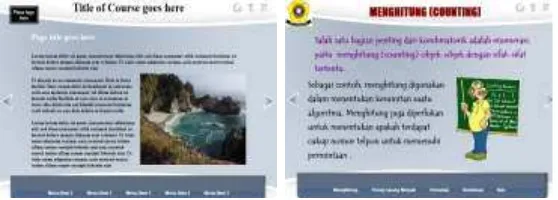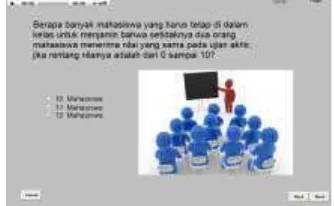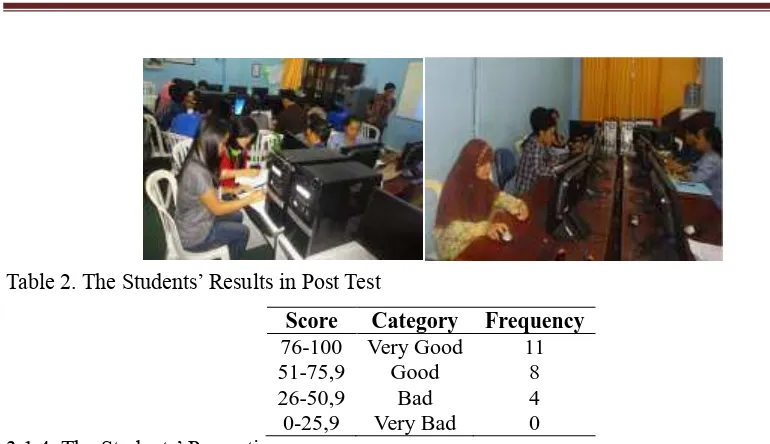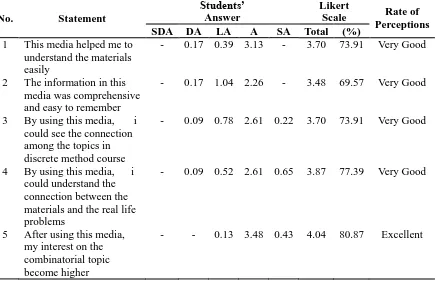ME-65
DEVELOPMENT OF INTERACTIVE LEARNING MEDIA BASED LECTORA
INSPIRE IN DISCRETE METHOD COURSE
Alfensi Faruk
Sriwijaya University
email: [email protected]
Abstract
This study aims to (1) produce a valid and practical interactive learning media based Lectora Inspire in a discrete method course, (2) see the effects of the developed learning media to the students’ learning outcome in a discrete method class. Research and development, which consists of five stages: pre-development, development, evaluation, field test, and revision, was implemented in this study. The developed interactive learning media was tested against 23 students of discrete method class in the Department of Mathematics, Faculty of Mathematics and Natural Science, Sriwijaya University. The results of the analysis are: (1) based on the evaluation of the experts and the perceptions of the students, the interactive learning media which has been developed was valid, practical, and highly recommended to be used as a source of student’s self-learning in discrete method courses, (2) the interactive learning media which has been developed was effective to increase students’ learning outcome.
Keywords: Interactive learning media, lectora inspire, discrete method
1. INTRODUCTION
1.1. Background
Discrete method is one of the compulsory course in Department of Mathematics, Faculty of Mathematics and Natural Science, Sriwijaya University. Based on the data at the end of the even semester of academic year 2012/2013, the students’ average score on that course is still low. It happened due to the lack of the students’ motivation and understanding of the course materials. In addition, the teaching and learning process in this course still used conventional learning media such as books, modules, and static power point file (ppt without animations). Therefore, an interactive learning media that can create a two-way interaction between the students with the media and the learning resources is needed in the students’ learning process.
The ability of Macromedia Flash, which can make various interesting animations, has made the software became popular in the development of interactive learning media. Some examples are the works by Garcia et al. (2005), Luthfi & Nafi’ (2011), and Safitri et al. (2013). Interactive learning media are not only developed by using Macromedia Flash but also by using any other computer software, some example works are by Korakakis et al. (2009) who develop an interactive computer application to support the learning process for students in the 8th grade, and Khalid et al. (2010) committed a study to know the effect of work group method and interactive learning media in algebra learning of engineering students, another work was also done by Lee et al. (2012) that made interactive multimedia modules in electrochemistry learning and it was aimed to see the effect of the developed modules toward the students’ understanding and learning motivation.
Although interactive learning media have been widely developed, there are not many teachers using it in their class. It happened because they are still lack about web management and design graphics technic. Therefore, one of the aims of this study is to develop an interactive learning media using a special software for interactive media and e-learning, namely Lectora Inspire. This software is an authoring tool which can be easily used by any common teachers and lecturers to make contents of interactive learning media. Another aim of this study is to see the effects of the developed learning media to the students’ learning outcome in a discrete method class. To reach the latter aim, we have tested the developed interactive learning media against the students of discrete method class in the Department of Mathematics, Faculty of Mathematics and Natural Science, Sriwijaya University.
1.2. Formulations of The Problem
Based on the background, the formulations of the problem of this research project are: 1.How to produce a valid and practical interactive learning media based Lectora Inspire in a
discrete method course?
2.How the developed interactive learning media affect the students’ learning outcome in a discrete method class?
1.3. Aims and Benefits of The Study
The aims of the study are:
1. To produce a valid and practical interactive learning media based Lectora inspire in a discrete method course.
2. To see the effects of the developed learning media to the students’ learning outcome in a discrete method class.
The benefits of this study are:
1. To give a learning resource which based on information technology for both the lecturers and students in a discrete method course.
2. It is expected to be more and more lectures are using interactive learning media in a math class, especially in the subjects of discrete methods.
2. RESEARCH METHOD
2.1. Design
Research and development cycle design was used in this study, and it has been modified and fitted to the research aims. The research design contains of five stages, i.e. pre-development, pre-development, evaluation, field test, and revision.
2.2. Subjects
The subjects of this research are 23 students (10 male and 13 female) of Department of Mathematics, Faculty of Mathematics and Natural Science, Sriwijaya University. All the tudents have taken the discrete method course class A in the semester of academic year 2012/2013.
2.3. Procedure
ME-67
when all the development process in the second stage has been completed. Two experts in multimedia and content, who have been already selected, gave their opinions, criticisms, and suggestions about the developed interactive learning media.
After the interactive learning media had been fixed based on the experts’ advices, then it was ready to be tested. The field test stage consists of three sub-stages, that is pre test, implementation, and post test. Each sub-stages took place about fifty minutes and the students should fill out the questionnaires at the end of the test. This test conducted in the Laboratory of Computation, Department of Mathematics, Faculty of Mathematics and Natural Science, Sriwijaya University. In the revision stage, some advices from the students were selected as the basis for the improvement of the developed interactive learning media.
2.4. Instruments
2.4.1. Achievement test
There are two kinds of tests that were conducted in this study, namely a pre test and a post test. The questions on the tests cover the basic knowledges that should be already studied by the students who already took a discrete method course.
2.4.2. Questionnaire
There are three kinds of statements of the students’ perception questionnaire, namely perceptions about the multimedia and accessibility, perceptions about the content of materials, and perceptions about the example questions and quiz.
3. RESULTS AND DISCUSSION
3.1. Results
3.1.1.The Interactive Learning Media
One of the benefits using Lectora Inspire is there are so many templates for interactive learning media which can be choosen. The face-to-face display for the developed interactive learning media is given in the figure 1. The left side of the figure 1 shows default template and the right side shows the adjusted template.
Figure 1. Adjustment of a default template with the learning contents
Musics and sound effects are also added to the developed interactive learning media. The videos which added to the media are made in format of flash video. To play a video in Lectora Inspire, we have to download flash player program which can be downloaded freely from the website http://get.adobe.com/flashplayer/.
image are also added to each question, and then a time limit of 3 minutes is also given for the students to answer each question. The students can access this test simulation at any time without having to read all the material by directly clicking the quiz menu button. Figure 2 shows an example question of the quiz.
Figure 2. A multiple choice type question 3.1.2. Expert Review
There are two experts who reviewed the developed interactive learning media, namely a multimedia expert and a content expert. Both of them have given some suggestions to the media and they also thought that the developed interactive learning media were practical and valid to be used in a discrete method course.
3.1.3. Field Test
This field test was conducted to know the effects of interactive learning media on students’ learning outcomes. There are three steps in this field test, that is conducting a pre test, learning using the media, and conducting a post test. All the activities of field test took place on 8th of November, 2013.
The pre test was administered to determine the students’ baseline knowledge of the course materials. There are four questions that were given to the students in the pre test and it cover almost all the basic topics in combinatorics. Based on the test that has been conducted on the students, the average scoreobtained at the pre test is 58,7. It can be seen that the students’ pre test score is categorized as low because it below 60 scales of 100. The students’ results in pre test are completely shown in table 1 below.
Table 1. The Students’ Results in Pre Test
Score Category Frequency 76-100 Very Good 0
51-75,9 Good 11
26-50,9 Bad 9
0-25,9 Very Bad 3
ME-69
Figure 3. The students explored the interactive learning media
Table 2. The Students’ Results in Post Test
Score Category Frequency 76-100 Very Good 11
51-75,9 Good 8
26-50,9 Bad 4
0-25,9 Very Bad 0 3.1.4. The Students’ Perceptions
When all the steps in the field test phase have been completed, the students had to fill out the given questionnaires. Generally, the statements in the questionnaires are divided into three aspects, namely perceptions about the multimedia and accessibility, perceptions about the contents or materials, and perceptions about the questions of the quiz. In this questionnaire, all the students can also give their opinions and suggestions about the interactive learning media by writing it in a special column on the last page of the questionnaire.
The first aspect is the students’ perceptions about the multimedia and accessibility of the developed interactive learning media. This students’ perceptions are summarized and shown in table 3. On that table, the perception rates about the multimedia, that are stated in the statement 1 to 4, are excellent. Statement number 5 is the students’ perception about the accessibility of the interactive learning media. Very good rate is given by the students. One of the reasons is because the menu-driven system in the media makes them should not start the learning from the beginning, otherwise they can directly go to the desired materials by pressing the appropriate menu button.
Table 3. Students’ Perceptions about The Multimedia and Accessibility
No. Statement
Students’
Answer Likert Scale Rate of
Perceptions
SDA DA LA A SA Total (%)
1 Face-to-face display is so interesting
- - - 2.96 1.30 4.26 85.22 Excellent
2 Pictures and texts are so interesing
- - 0.26 3.13 0.65 4.04 80.87 Excellent
3 Sounds and musics are so interesting and enjoyable
- - - 2.78 1.52 4.30 86.09 Excellent
4 Animations and videos are so interesting
- - 0.13 2.96 1.09 4.17 83.48 Excellent
explore this media are easy
Explanation : SA=Strongly Agree; A=Agree; LA=Less Agree; DA=Disagree; SDA=Strongly Disagree
Likert Scale : 0%-20% = Very Bad; 20.01%-40% = Bad; 40.01%-60%= Good; 60.01%-80%= Very Good; 80.01%-100%= Excellent
The students’ perception rate about the given materials in the developed interactive learning media are very good in the average as shown in table 4. After the students have learned the interactive learning media, their interest to the combinatorial topic became higher than before as shown by the rate of perceptions in statement number 5.
Table 4. Students’ Perceptions about The Content of Materials
No. Statement
Explanation : SA=Strongly Agree; A=Agree; LA=Less Agree; DA=Disagree; SDA=Strongly Disagree
Likert Scale : 0%-20% = Very Bad; 20.01%-40% = Bad; 40.01%-60%= Good; 60.01%-80%= Very Good; 80.01%-100%= Excellent
The perception rates of the students toward the given example questions and quiz in this interactive learning media are excellent as shown in table 5 below.
Table 5. Students’ Perceptions about The Example Questions and Quiz
ME-71 in this media were not
difficult for me to understand and solve 2 The ilustration of the example questions was so interesting and made me more concentrated
- - 0.39 2.61 1.09 4.09 81.74 Excellent
3 I was enjoying to do the test or quiz in this media
- - 0.13 3.13 0.87 4.13 82.61 Excellent
Explanation : SA=Strongly Agree; A=Agree; LA=Less Agree; DA=Disagree; SDA=Strongly Disagree
Likert Scale : 0%-20% = Very Bad; 20.01%-40% = Bad; 40.01%-60%= Good; 60.01%-80%= Very Good; 80.01%-100%= Excellent
3.2. Discussion
In this study, flypaper™ became the main alternative software of Macromedia Flash in making animations for the developed interactive learning media. Among the three common types of animations for use in teaching: swf, exe, and avi, the swf type has the smallest size than the other (Garcia et al., 2007). The animations, that were designed using flypaper™, were
made in swf type, so that the animations may also be added to a web page such as math learning blog support (Arifin et al., 2010).
Results showed that students’ average pre test score are still low. Although they have taken the course before, the majority of the students still thinks that the combinatorial materials are difficult to understand as shown in their final score at the end of the semester of academic year 2012/2013. Then, the using of interactive learning media was applied to the students to increase their understanding and motivation (Lee & Osman, 2012) in the learning of discrete method, especially in combinatorial topic. This treatment successfully increased the students’ learning outcome. It showed by their average post test score that can be categorized as good, that is 72,61 scales of 100. This result was along with other works (Garcia et al., 2007; Arifin et al., 2010; Sazaliet al., 2010; Safitri et al., 2013) that made interactive learning media as one of potential novel learning techniques in general math learning.
Based on the students’ perceptions, multimedia which added into the developed interactive learning media has increased the students’ learning motivation. The same result was also committed by Khalid et al (2010) who showed that an interactive multimedia has an impact on students’ learning. It is because of a majority of the students, who are still young, think that learning with music is very enjoyable. The students also think that the varying animations, pictures, and text colours are so interesting. In their opinion, studying with the interactive learning media is very much like playing a game on their personal computer.
4. CONCLUSION AND SUGGESTION
4.1. Conclusion
Based on the results, the interactive learning media has been reviewed by the experts and some suggestions from them have been conducted to get a better interactive learning media. The students also gave their perceptions and they thought that the developed interactive learning media should be used regularly in discrete method class, although there are some aspects that have to be improved. Therefore, it can be concluded that the developed interactive learning media is practical and valid to be used in a discrete method course.
The interactive learning media have significant effects to increase the students learning outcome. It showed by the results of the field test that has been committed against 23 students of discrete method class in the Department of Mathematics, Faculty of Mathematics and Natural Science, Sriwijaya University. Based on the tests, the students’ average score increased to 72,61 in post test from 58,7 in pre test.
4.2. Suggestion
It is suggested that the interactive learning media should be used widely by the teachers and lecturers, because it is easy to be developed using an authoring tool such as Lectora Inspire. The materials of the interactive learning media which have been developed do not contain all the materials in a discrete method course, therefore for the next development someone should develop a complete discrete method learning media.
5. BIBLIOGRAPHY
Arifin S., Zulkardi, &Darmawijoyo. 2010. Pengembangan Blog Support Pembelajaran Matematika Sekolah Menengah Atas. Jurnal Pendidikan Matematika 4 (2): 70-85 Garcia R. R., Quiros S. J., Santos G. R., Gonzalez, M. S., &Fernanz, M. S..2005. Interactive
multimedia animation with Macromedia Flash in Descriptive Geometry Teaching.
Computers & Education 49: 615–639
Khalid, M. S., Alias, M., Razally, W., Yamin, S., &Herawan, T.. 2010. The Influence of Teamwork Using a Multimedia Interactive Courseware in Learning Pre-Algebra.
Procedia Social and Behavioral Sciences 8: 654–662
Korakakis, G., Pavlatou, E. A., Palyvos, J. A., &Spyrellis, N.. 2009. 3D visualization types in multimedia applications for science learning: A case study for 8th grade students in Greece. Computers & Education 52(3): 390–401.
Lee, T. T.,&Osman, K.. 2012. Interactive multimedia module in the learning of electrochemistry: effects on student’s understanding and motivation. Procedia - Social and Behavioral Sciences 46: 1323 – 1327
Lutfi, K., &Nafi’, M.. 2011. Interactive Multimedia Based Learning Media For Javanese Letters Using Macromedia Flash 8. http://eprints.uny.ac.id/id/eprint/5965
Safitri, M., Hartono, Y., &Somakim. 2013. Development Of learning media Based Macromedia Flash About Triangle For Student Grade 7 Junior High School.Proceeding The First South East Asia Design/Development Research (SEA-DR) International Conference. Palembang: 22-23 April 2013. Palembang: 241-250.



